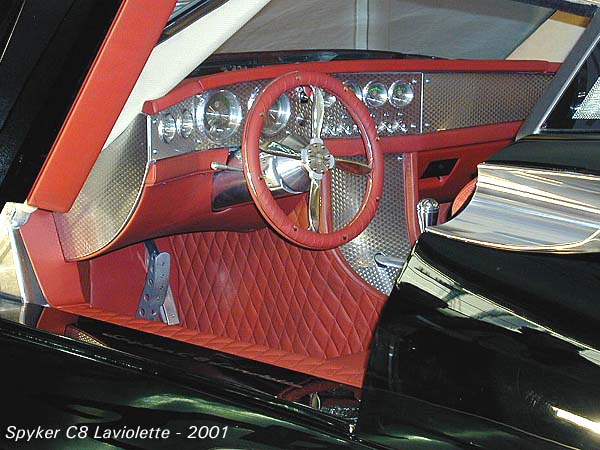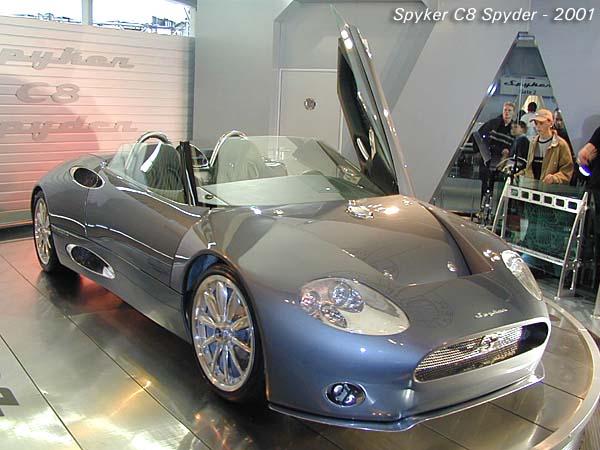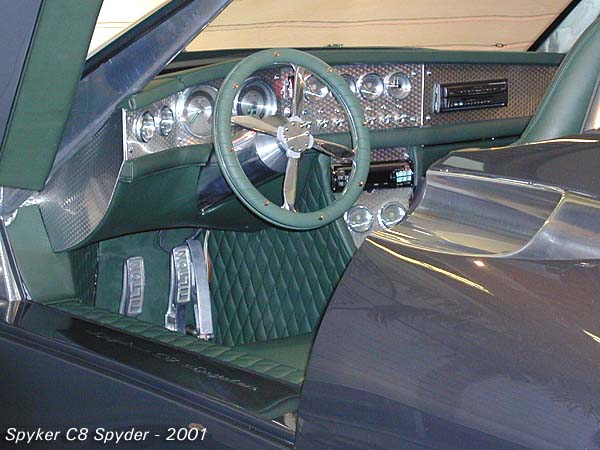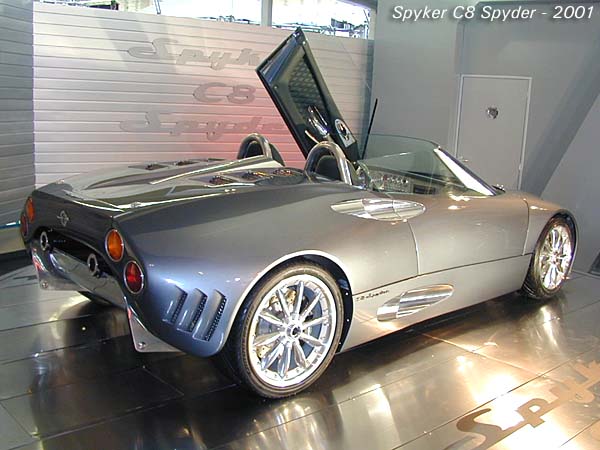|
 This
is the interior of the Spyker C8 Laviolette, luxurious yet racy with lots of
aluminum and leather. The steering wheel has a propeller design (called
"Aeroblade") reminiscent of the Spyker logo; the same styling is
applied to the wheel rims of the car. This
is the interior of the Spyker C8 Laviolette, luxurious yet racy with lots of
aluminum and leather. The steering wheel has a propeller design (called
"Aeroblade") reminiscent of the Spyker logo; the same styling is
applied to the wheel rims of the car.
The C8 is a "key-less" car: a personal security card activates all
electrical systems of the car within a radius of 3 metres. In cooperation with
the British MoTeC company an engine management system has been developed which
not only controls the power output of the engine (complete with data logging),
but also supports drive-by-wire operation.
A remarkable aspect of the C8 design are the upward opening doors (much like
those of the Lamborghini Diablo). The special aluminum hinges for this
construction are patented by Spyker. Another new Spyker patent is for the
decentralized electrical wiring system with self adjusting fuses which should
guarantee simplicity, safety and reliability.
Though the concept of and target group for the C8 Laviolette are
quite different from those of the original Spyker cars, there are also quite a
number of similarities: the elaborate engineering, the innovative thinking and,
not in last place, the exorbitant price. Indications suggest a price surpassing
that of Aston Martins, Ferraris and even Lamborghinis. Which introduces another
typical Spyker feature: extremely limited production.
 Even
though the prototype was a coupe, the first production car the new Spyker
company presented was a roadster. The Spyker C8 Spyder was introduced in October
2000 at the Birmingham Motorshow in England. Surprisingly it was a tremendous
success; it won an award for Engineering Excellence in the Specialist Low Volume
Manufacturers category and quite a number of orders were placed. Even
though the prototype was a coupe, the first production car the new Spyker
company presented was a roadster. The Spyker C8 Spyder was introduced in October
2000 at the Birmingham Motorshow in England. Surprisingly it was a tremendous
success; it won an award for Engineering Excellence in the Specialist Low Volume
Manufacturers category and quite a number of orders were placed.
The original Spyker company always had a strong connection with England. A
considerable part of their production was sold there, the local motoring press
was usually very positive about the quality of their products and the Spyker
sporting and record achievements were held in high regard. And because of that
it's not so strange that the new Spyker production model was shown to the public
in England first, with the desired effect.
 Another
reason for introducing it in England, besides the soft spot the British have for
exotic vehicles, was the strong British participation in the model. Most of it
was made by Coventry Prototyping & Panels in England, of course under
supervision of Maarten de Bruijn. Also a number of engineering tasks have been
carried out by a collection of British specialist firms. Another
reason for introducing it in England, besides the soft spot the British have for
exotic vehicles, was the strong British participation in the model. Most of it
was made by Coventry Prototyping & Panels in England, of course under
supervision of Maarten de Bruijn. Also a number of engineering tasks have been
carried out by a collection of British specialist firms.
Still the Spyker will remain a Dutch car. The factory is located in Zeewolde,
where the assembly takes place. The chassis are produced by Polynorm Automotive
in Bunschoten and the engine modifications are carried out by Cavallino
Engineering, a well-known Dutch racing car constructor. Coventry Prototyping
& Panels remains responsible for producing the aluminum body panels.
The name "Spyder" for the roadster model has little to
do with Spyker history. It's just an attractive name for this body style,
normally used by Italian manufacturers. Originally the word was an Italian
designation for a light, open two-seater carriage.
 From
the rear the Spyder looks most attractive. The polished metal details and
air-intakes catch the eye and are tastefully combined with the "agate
grey" paintwork. The low, almost horizontal lines give the car a racy
appearance and the "gills" behind the rear wheels are very
distinctive. But what impressed me most was the professional and appealing
presentation of both the Spyder and the Laviolette coupe, a lot of time and
effort must have gone into that as well. From
the rear the Spyder looks most attractive. The polished metal details and
air-intakes catch the eye and are tastefully combined with the "agate
grey" paintwork. The low, almost horizontal lines give the car a racy
appearance and the "gills" behind the rear wheels are very
distinctive. But what impressed me most was the professional and appealing
presentation of both the Spyder and the Laviolette coupe, a lot of time and
effort must have gone into that as well.
The technical aspects of the Spyder are similar to that of the Laviolette coupe:
aluminum light-weight construction, a 4172 cc Audi V8 placed behind the seats
(mid-engined lay-out), a 6-speed gearbox and rear wheel drive. Interesting
details are the flexible Formula 1-style petrol tanks on either side of the
cockpit, placed in the chassis construction underneath the doors, and the fully
adjustable racing style independent front and rear wheel suspension. The Spyder
weighs an even 1000 kg and measures 405 x 188 x 117 cm (length x width x
height). Its engine produces 400 hp @ 6500 rpm in standard trim, which should be
enough for topping 300 kph.
|
